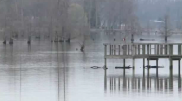Santa Barbara Oil Spill: A Brief History
Although it could be argued that no time is a good time for any oil spill, the attention the Santa Barbara oil spill happened at a particularly advantageous point in environmental legislation history.
Some credit the extensive media coverage of this spill as further awakening the environmental consciousness of the United States. The National Environmental Policy Act, the Environmental Protection Agency, the Clean Water Act and even Earth Day were enacted in the years immediately following this disaster. Many proponents of these and other eco-decrees would directly credit the spill as spurring them into action.
***
On January 28, 1969, a blowout at a Union Oil platform six miles off the coast of Santa Barbara, Calif. would soon become one of the most iconic environmental disasters in U.S. history.
It took 11 days for workers to cap the initial leak. However, citizens reported a large slick still growing on the surface, later discovered to be pouring from ruptures on the ocean floor surrounding the initial blowout. These would be harder to control, resulting multiple leaks of 4,000 gallons per day for months.
Officials were quick to offer promises and new legislation. Secretary of the Interior Walter J. Hickel said on Feb. 26 that stiffer laws should be put into place to protect offshore areas from all pollution. When he visited the site on Mar. 21, Nixon even promised federal troops to help control the situation, if the need should arise.
But the promises weren't quick enough. The spill's media coverage was extensive and the government's inaction was apparent. The ecosystem of the Santa Barbara coast was getting slammed and response was slow.
Oil was mainly concentrated on a 35-mile stretch of coast nearest to the spill, but some patches were found as far north as Pismo Beach and as far south as the Mexican boarder.
Thousands of birds, covered in oil, washed up on shore.
"What a rape!" Peter Lundgren, Carpinteria area resident, told the Washington Post. "I just saw a duck covered with oil about a half mile up the beach. He drowned. He was trying to fly but his wings were so heavy that he just went under the waves. He didn't come up again."
Over the 45 days following the disaster, the beaches were slowly cleaned. The oil was left to float ashore and then bulldozers and cleaners would collect it.
Detergents were sometimes used but not quite as much as during 1967's Torrey Canyon disaster. This meant more marine life remained unharmed. Still, between the steam-cleaning of rocks (which literally cooked the mussels attached) and the stagnant oil, it was not ideal.
By June, workers were able to reduce the leakage down to 10 barrels per day. That rate would continue through the rest of the year.
Many at the time argued that more could be done. Conservationists began to rally. Quiet, coastal communities became the front lines in the battle for environmental protection. Small organizations cropped up, petitions were signed, protest songs were sung.
In response to this organizational effort, the early 1970s would bring major environmental protection laws and agencies to fruition, such as those mentioned at the outset.
The Santa Barbara oil spill remains as the third largest oil spill in U.S. waters, directly behind the 2010's BP oil spill and 1989's Exxon Valdez tanker collision. The lesson it taught the nation continues to inspire a new generation of conservationists through to this day.





